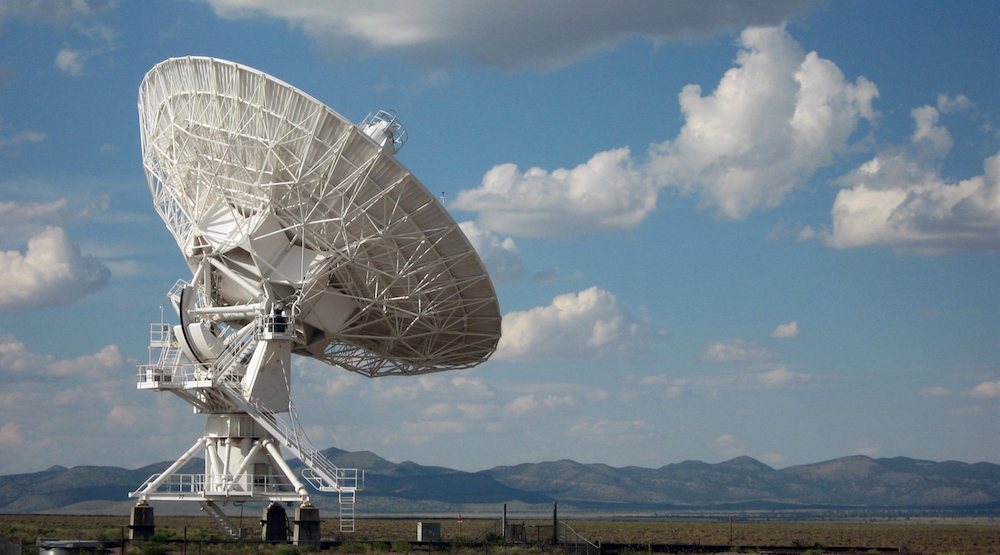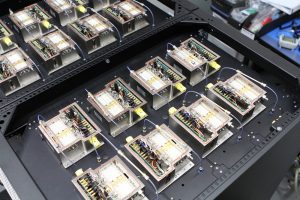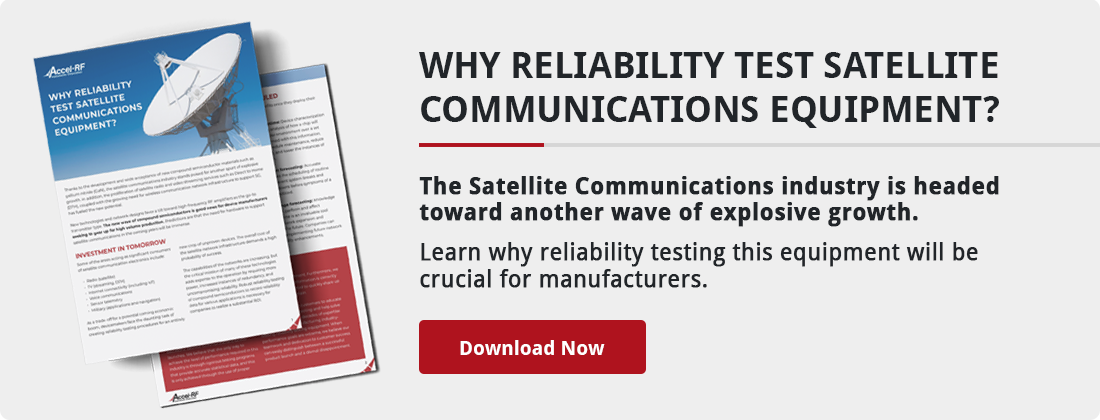![]()
SATELLITE COMMUNICATIONS OPERATIONS
Many companies are now routinely operating in space. Commercial satellite communications, for the most part, work satisfactorily with existing silicon-based chipsets and technology.
The needs of government space programs are substantially different. Involvement with advanced activities like space exploration, observation of Earth’s environment, and military operations significantly increase performance requirements over that of most commercial ventures.

GAN CHIPS MEET THE NEED
Currently, equipment to meet these more rigorous tasks rely on the recent integration of Gallium Nitride (GaN) technology. This material’s ability to produce devices with higher power density, tolerance to extreme temperatures and radiation, and high-frequency capability make them suitable for the difficulties of space.
The problem lies in the fact that GaN has not been around long enough to have accumulated extensive reliability data when compared to Silicon or Gallium Arsenide (GaAs). There are very few published examples of GaN being used as the building block for a satellite transmitter to draw on for confidence. With billions in money from tight public budgets funding space programs worldwide, program officials and their supply chains of vendors and system integrators, can’t afford to take chances with unproven technologies.
IMPORTANT RELIABILITY PARAMETERS OF CONCERN
DC Bias Current
Active semiconductor components require a DC power supply to operate. The DC bias voltage and current levels are critical parameters as the power dissipation of each active element will contribute to temperature rise and drive overall efficiency.
Industries:
![]()
![]()
![]()
![]()
![]()
![]()
![]()
![]()
RF Output Power
The RF output power of an amplifier drives the overall capabilities of a transmitter. The saturation level and how the output power of a device compresses with input power is used to determine which applications and systems are suitable for that device.
Industries:
![]()
![]()
![]()
![]()
![]()
![]()
![]()
RF Gain
The ratio of RF power delivered to a load relative to the input power. How gain changes and compresses as these levels rise and approach saturation is critical to designing systems for any RF application.
Industries:
![]()
![]()
![]()
![]()
![]()
Ohmic Contact Resistance
In semiconductors, this is the intrinsic resistance through the metalized terminals of the device into the channel or junction. A physical change in the ohmic contacts, which can be an effect of metal migration, can change the resistance and impact the electrical performance of a device.
Industries:
![]()
![]()
Intermodulation Distortion
IMD occurs when two signals are present in a nonlinear system, such as an amplifier. The frequency harmonics of these two signals mix and create 2nd and 3rd order intermodulation products. Measuring and mitigating these distortion levels are critical for communication applications.
Industries:
![]()
![]()
![]()
![]()
Phase Noise
Commonly referred to as “jitter”, phase noise is the random fluctuations of the phase of a signal source. It is present in oscillators and digital clocks and can have detrimental effects on a system where frequency conversion takes place. A signal with high phase noise can end up occupying more of the spectrum than intended and introduce error.
Industries:
![]()
![]()
![]()
![]()
Noise Figure
This is a critical parameter in all Receiver designs. The Noise Figure must be low for a system to be sensitive enough to detect and process weak signals. Low Noise Amplifiers (LNA) are typically the first element in a receiver and are designed to minimize Noise Figure.
Industries:
![]()
![]()
![]()
![]()
![]()
Signal Linearity
For amplifiers in RF applications, this represents the relationship between the input power and the output power of a device. At low input power levels, linearity is uniformly quantified by the gain. As input drive increases, the device gain compresses as the device saturates and the linearity characteristics change.
Industries:
![]()
![]()
![]()
![]()
![]()
Switching Response Time
The rise and fall time of RF switches used in high-frequency applications can set limitations on the bandwidth and other key aspects of a system. When used in a phased array, the switching speed can limit how quickly the beam can be steered, for example.
Industries:
![]()
![]()
![]()
![]()
Frequency Stability
This represents the ability of a source, such as an oscillator, to maintain a constant frequency output. Outside influences such as temperature and change in bias voltage can lead to drift and affect frequency stability. Stability in communication systems is required so that a signal does not drift outside of its designated band.
Industries:
![]()
![]()
![]()
![]()
![]()
![]()
Satellite Communications will pertain to the “ground” segment of the communications network. Since the ground segment market is located on the ground and not in space, the reliability assurance requirements are very different. However, the application and network reliability are still paramount to the market and the user community involved in satellite communications.
Satellite communications find its applications in the following areas:
- Radio broadcasting.
- TV broadcasting such as Direct-to-Home (DTH).
- Internet applications such as providing a connection for data transfer, GPS applications, internet surfing, etc.
- Voice communications.
- Research and development sensor telemetry.
- Military applications and navigations.
The ground segment of the satellite communications industry covers many different market applications. Some markets deal with data transmission and are typically small aperture (small antenna realization) configurations. Other applications for TV broadcasting or lower frequency networks will have very large antenna structures (earth-stations).
For most of these applications the drivers for reliability testing are:
- Overall cost of the satellite network demands high probability of success.
- Maintenance cost (down-time) leads to lost revenue since most ground segment is leased or pay-per-use market.
- Maintenance cost for repair/replacement of expensive subsystems.
- System return-on-investment (ROI) plans are usually “long-life” expectations (>>10 years of service).
- Maintenance is not easy to accomplish due to remote location of the system.
- Performance degradation with age drives maintenance service costs and lower ROI.
ACCEL-RF PROVEN RELIABILITY TESTING EQUIPMENT
Accel-RF has extensive experience testing GaN devices for use in space and many other applications. Turnkey, customized solutions offer a proven way to move forward boldly with designs with the confidence that performance and reliability will meet the mission requirements.

TESTING CRITICAL AT ALL POINTS ALONG THE SUPPLY CHAIN
A single test doesn’t exist that will ensure satellite components will do the job as intended. Different application requirements place parts in wildly varying conditions.
Test facilitators must design tests that approximate the conditions of space and understand how to analyze the data obtained to know what adjustments to make. For GaN to operate in this arena successfully and reliably, qualification must occur at several points along the product life cycle.
- Intrinsic reliability: Before a device can be added to the Bill of Materials for a module earmarked for a satellite, the expected lifetime must be quantified to ensure it will operate well beyond the expected mission life. This is typically accomplished through Accelerated Life Testing, which can provide valuable lifetime estimates in a reasonable period of time. Results and physical and chemical analysis of the feedback of the tested device to the process engineers to fine-tune and improve the reliability of future lots until a formula suitable for space is finalized.
- Device-level quality: Once production begins, manufacturers rely on burn-in testing to weed out defective parts from the population. Analyzing data from burn-in trials helps determine what adjustments can be made on higher-level assemblies in order to improve yield.
- Application-specific operating life: System integrators benefit from testing that places the device under the exact conditions expected when in-use. This can include using the planned modulation scheme for communications satellites or even involve subjecting the part to environmental factors, such as extreme temperature or radiation.
Testing at just one point on the supply chain will not provide confidence in the reliability necessary for these operations. Space program officials and vendors have begun moving toward a coordinated understanding of what is needed to fully qualify the use of GaN devices in space.

MODULAR TESTING SOLUTIONS OFFER FLEXIBILITY
Accel-RF designs solutions for any phase of the development process. Accel-RF engineers have planned the entire line of testing solutions to work together or to integrate with existing equipment.

The Automated Accelerated Reliability Test Set is the industry standard for performing intrinsic reliability analysis through accelerated life testing. Its modularity also allows true application-specific operating life testing to be performed on devices intended for space applications. The RF-Biased Burn-In System supports testing a large quantity of devices at once to screen out potential early failures that would be unacceptable in a satellite.
The modular design of the equipment makes it easy to customize to fit the application. Test labs can retrofit existing setups instead of configuring entirely new testbeds for each device. Setting up different test environments in the same space quickly and cost-effectively is a huge advantage and time saver.
A TESTING PARTNER TO ENSURE SUCCESS
Accel-RF has worked with the European Space Agency (ESA) to provide testing solutions for that agency’s advanced Earth environmental studies. They understand the complexities and pressures of successful space operations. Every device in every component in every system must function flawlessly for the program to meet its goals. The only way to achieve this level of performance is through rigorous testing programs that provide accurate statistical data. That data must be correctly interpreted and in a format that is easy to share up and down the supply chain.
Accel-RF believes in partnering with the customers it serves. Its experts understand every aspect of reliability testing at each phase of a project. They help customers understand what they need to test, perform the test in the best way, and correctly interpret the resulting data.
Accel-RF doesn’t just sell testing equipment and leave you on your own to learn how to use it. The engineers at Accel-RF view themselves as educators whose job it is to help solve problems. They pride themselves in explaining each necessary step in the process in a way that everyone understands. They believe it is essential for everyone to know what tests are needed and why they are required.
When performance goals are extreme like they are in space operations, that sort of teamwork and dedication to customer success can easily spell the difference between failure and mission accomplished.
Why Reliability Test Satellite Communications Equipment?
The satellite communications industry is poised for more explosive growth. New tech is favoring high-frequency RF amplifiers and the need for hardware to support satellite communications in the coming years is likely to be immense. Check out our guide to learn more.
